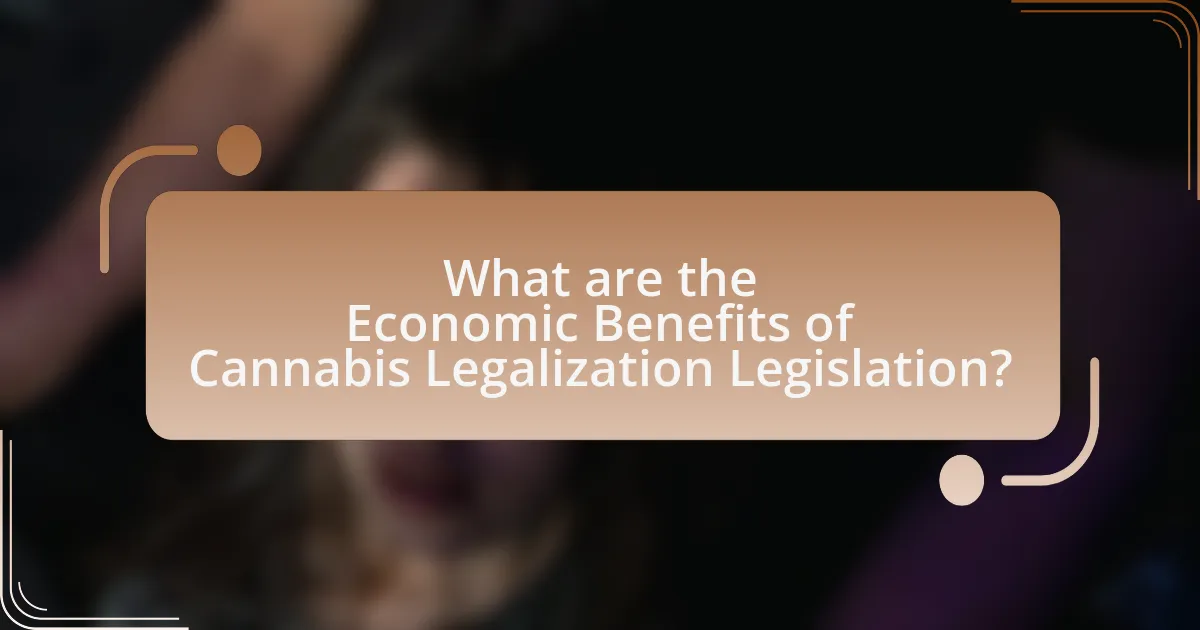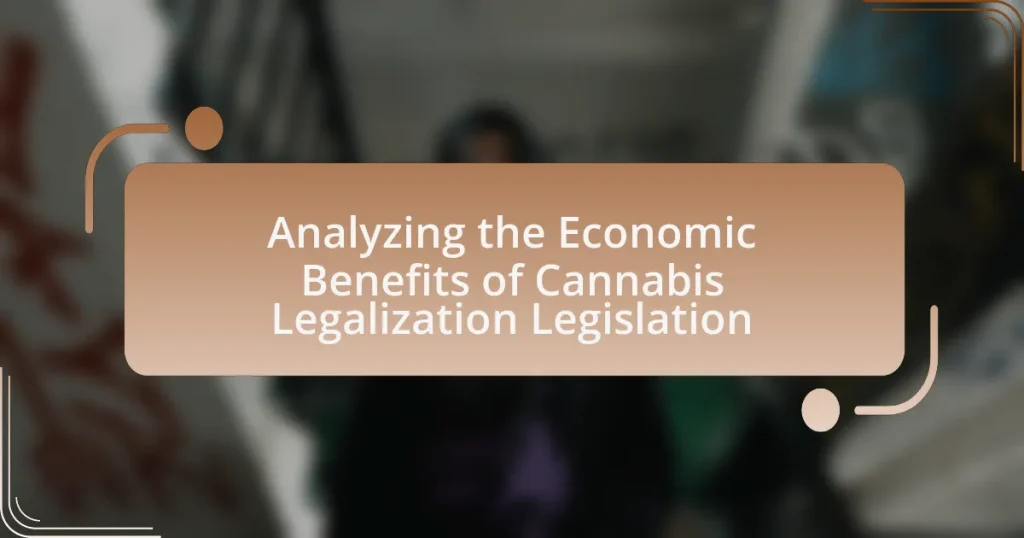The article analyzes the economic benefits of cannabis legalization legislation, highlighting key aspects such as increased tax revenue, job creation, and reduced law enforcement costs. It details how states like Colorado have generated significant tax income, with over $1.7 billion collected from cannabis sales, and discusses the creation of hundreds of thousands of jobs within the industry. Additionally, the article examines the positive impacts on local economies, public health outcomes, and crime rates, while addressing potential challenges and best practices for maximizing economic benefits through effective regulatory frameworks and stakeholder collaboration.

What are the Economic Benefits of Cannabis Legalization Legislation?
The economic benefits of cannabis legalization legislation include increased tax revenue, job creation, and reduced law enforcement costs. Legalizing cannabis allows governments to impose taxes on its sale, generating significant revenue; for example, Colorado collected over $1.7 billion in tax revenue from cannabis sales between 2014 and 2020. Additionally, the cannabis industry creates jobs in cultivation, distribution, and retail, contributing to employment growth; the industry is projected to create over 1 million jobs by 2025 in the United States alone. Furthermore, legalization reduces law enforcement expenditures related to cannabis prohibition, allowing funds to be redirected to other public services. These factors collectively demonstrate the substantial economic advantages of cannabis legalization.
How does cannabis legalization impact local economies?
Cannabis legalization positively impacts local economies by generating significant tax revenue and creating job opportunities. For instance, states like Colorado have reported over $1.5 billion in tax revenue since legalization in 2014, which has been allocated to education, infrastructure, and public health programs. Additionally, the cannabis industry has created tens of thousands of jobs, with Colorado alone seeing an increase of over 30,000 jobs in the sector. This economic activity stimulates local businesses, increases consumer spending, and enhances overall economic growth in communities that embrace legalization.
What are the immediate financial effects on local businesses?
The immediate financial effects on local businesses following cannabis legalization include increased revenue from cannabis sales, job creation, and heightened consumer spending. Legalization often leads to a surge in local dispensaries and related businesses, which can boost tax revenues for municipalities. For instance, Colorado reported over $1 billion in cannabis sales in 2020, generating significant tax income that supports local infrastructure and services. Additionally, the establishment of cannabis-related businesses creates jobs, contributing to lower unemployment rates in the area. This influx of economic activity can stimulate growth in ancillary sectors, such as real estate and hospitality, further enhancing the financial landscape for local businesses.
How does cannabis legalization influence job creation?
Cannabis legalization significantly influences job creation by generating new employment opportunities across various sectors. Legalizing cannabis leads to the establishment of dispensaries, cultivation facilities, and manufacturing plants, which require a workforce for operations. For instance, a report from the Leafly Jobs Report in 2021 indicated that the legal cannabis industry in the United States supported over 321,000 full-time jobs, reflecting a 32% increase from the previous year. Additionally, ancillary businesses such as security, marketing, and legal services also benefit from the growth of the cannabis sector, further contributing to job creation. Thus, the legalization of cannabis not only creates direct employment within the industry but also stimulates job growth in related fields.
What are the tax revenue implications of cannabis legalization?
Cannabis legalization significantly increases tax revenue for governments. For instance, states like Colorado and California have generated hundreds of millions in tax revenue since legalizing cannabis; Colorado reported over $387 million in tax revenue in 2020 alone. This revenue comes from various taxes, including sales tax, excise tax, and licensing fees, which contribute to funding public services such as education, healthcare, and infrastructure. Additionally, the legal cannabis market reduces the costs associated with law enforcement and incarceration related to cannabis offenses, further enhancing the overall economic benefits of legalization.
How do tax revenues from cannabis compare to other industries?
Tax revenues from cannabis are significant, often surpassing those from traditional industries such as alcohol and tobacco. For instance, in 2021, legal cannabis sales in the United States generated approximately $3.7 billion in tax revenue, while the alcohol industry contributed around $11.5 billion in federal excise taxes. However, cannabis tax revenues are growing rapidly, with states like Colorado reporting over $2 billion in total tax revenue since legalization in 2014. This trend indicates that as cannabis markets expand, their tax contributions may increasingly rival or exceed those of established industries.
What are the potential uses of tax revenue generated from cannabis sales?
Tax revenue generated from cannabis sales can be utilized for various public services and initiatives. These uses typically include funding for education, healthcare, infrastructure improvements, and public safety programs. For instance, in Colorado, which legalized cannabis in 2012, over $1 billion in tax revenue has been allocated to public schools, mental health programs, and substance abuse treatment initiatives. This demonstrates how cannabis tax revenue can significantly contribute to essential state services and community welfare.
What social and economic factors are influenced by cannabis legalization?
Cannabis legalization influences various social and economic factors, including tax revenue generation, job creation, public health outcomes, and criminal justice reform. Legalization leads to increased tax revenues; for instance, Colorado generated over $1.7 billion in tax revenue from cannabis sales between 2014 and 2021. Job creation is significant, with the cannabis industry employing over 400,000 workers in the United States as of 2021, contributing to economic growth. Socially, legalization can improve public health by regulating product safety and reducing opioid prescriptions; studies indicate that states with legalized cannabis have seen a 25% reduction in opioid-related deaths. Additionally, cannabis legalization can lead to criminal justice reform by decreasing arrests for possession, which disproportionately affects marginalized communities; in 2020, the American Civil Liberties Union reported that Black individuals were 3.64 times more likely to be arrested for cannabis possession than white individuals, highlighting the social impact of legalization.
How does cannabis legalization affect public health expenditures?
Cannabis legalization generally leads to a reduction in public health expenditures. Studies indicate that states with legalized cannabis experience lower rates of opioid prescriptions and related healthcare costs, as cannabis is often used as an alternative for pain management. For instance, a study published in the Journal of Health Economics found that states with medical cannabis laws saw a 25% reduction in opioid overdose deaths, which correlates with decreased healthcare costs associated with treating opioid addiction and its complications. Additionally, the tax revenue generated from cannabis sales can be allocated to public health initiatives, further enhancing overall health outcomes and potentially lowering expenditures in the long term.
What role does cannabis legalization play in reducing crime rates?
Cannabis legalization plays a significant role in reducing crime rates by decreasing the illegal drug market and associated criminal activities. Legalizing cannabis allows for regulated sales, which diminishes the power of illegal dealers and reduces violence related to drug trafficking. For instance, a study published in the journal “PLOS ONE” found that states with legalized cannabis experienced a decrease in violent crime rates by approximately 13% compared to states where cannabis remains illegal. Additionally, the legalization leads to increased law enforcement focus on serious crimes rather than minor drug offenses, further contributing to overall crime reduction.
How can the economic benefits of cannabis legalization be maximized?
The economic benefits of cannabis legalization can be maximized by implementing a well-structured regulatory framework that includes taxation, licensing, and support for local businesses. A comprehensive taxation system can generate significant revenue; for instance, Colorado collected over $1.5 billion in tax revenue from cannabis sales between 2014 and 2020. Licensing ensures that businesses operate legally and safely, fostering a competitive market that can drive innovation and quality. Additionally, supporting local businesses through grants and training programs can enhance job creation and community investment, as seen in states like California, where cannabis-related jobs have increased significantly since legalization. By focusing on these strategies, states can optimize the economic advantages of cannabis legalization.
What strategies can be implemented to enhance local business participation?
To enhance local business participation in the context of cannabis legalization, strategies such as creating inclusive regulatory frameworks, providing financial incentives, and fostering community engagement can be implemented. Inclusive regulatory frameworks ensure that local businesses have access to licenses and permits, which can be supported by data showing that states with streamlined processes see higher participation rates. Financial incentives, such as tax breaks or grants for local cannabis businesses, can stimulate growth; for instance, Colorado’s cannabis tax revenue has funded local programs, demonstrating the economic benefits of supporting local enterprises. Lastly, fostering community engagement through workshops and informational sessions can educate local entrepreneurs about opportunities in the cannabis industry, as evidenced by successful initiatives in states like California, where local business participation increased significantly after community outreach efforts.
How can communities ensure equitable distribution of cannabis-related economic benefits?
Communities can ensure equitable distribution of cannabis-related economic benefits by implementing policies that prioritize local ownership and investment in the cannabis industry. For instance, establishing grant programs and low-interest loans for minority-owned businesses can facilitate access to capital, which is often a barrier for underrepresented groups. Additionally, communities can create zoning laws that favor local operators over large corporations, ensuring that profits remain within the community. Evidence from states like California shows that local equity programs have successfully increased participation from marginalized groups, leading to a more diverse cannabis market. Furthermore, ongoing community engagement and transparent decision-making processes can help identify and address the specific needs of different community members, ensuring that economic benefits are shared fairly.
What challenges might arise from cannabis legalization legislation?
Challenges that might arise from cannabis legalization legislation include regulatory inconsistencies, public health concerns, and potential increases in substance abuse. Regulatory inconsistencies occur when different states or regions implement varying laws, leading to confusion and enforcement difficulties. Public health concerns are significant, as legalization may lead to increased usage among vulnerable populations, particularly youth, which can exacerbate mental health issues. Additionally, studies indicate that states with legalized cannabis have seen a rise in emergency room visits related to cannabis use, highlighting potential health risks. Furthermore, the potential for increased substance abuse can strain public resources and healthcare systems, as evidenced by data from states where legalization has occurred.
How can potential negative economic impacts be mitigated?
Potential negative economic impacts can be mitigated through comprehensive regulatory frameworks that ensure responsible cannabis industry practices. Implementing strict regulations on cultivation, distribution, and sales can prevent market monopolies and protect small businesses, fostering a competitive environment. Additionally, investing in public education about responsible consumption can reduce potential health-related costs. Evidence from states like Colorado, which legalized cannabis in 2012, shows that regulatory measures have led to increased tax revenues while minimizing adverse economic effects, as the state generated over $1.5 billion in tax revenue by 2021.
What regulatory hurdles must be addressed to optimize economic benefits?
To optimize economic benefits from cannabis legalization, regulatory hurdles such as inconsistent state and federal laws, high taxation rates, and limited access to banking services must be addressed. Inconsistent laws create uncertainty for businesses, hindering investment and growth; for instance, the conflict between state legalization and federal prohibition complicates compliance and operational planning. High taxation rates can deter consumers and reduce overall market size, as seen in states where excessive taxes have led to thriving black markets. Additionally, limited access to banking services restricts financial transactions for cannabis businesses, making it difficult for them to operate efficiently and securely. Addressing these hurdles can create a more stable and profitable cannabis market, ultimately maximizing economic benefits.
What best practices can be adopted for successful cannabis legalization?
Successful cannabis legalization can be achieved by implementing comprehensive regulatory frameworks that prioritize public health, safety, and economic growth. Establishing clear guidelines for cultivation, distribution, and sales ensures compliance and reduces illegal market activity. For instance, states like Colorado and Washington have demonstrated that regulated markets can generate significant tax revenue, with Colorado collecting over $1.7 billion in cannabis tax revenue since legalization in 2014. Additionally, investing in public education campaigns about responsible use and potential risks can mitigate negative health impacts. Engaging stakeholders, including law enforcement, health professionals, and community members, fosters a collaborative approach that addresses concerns and promotes acceptance. These best practices create a balanced environment that maximizes the economic benefits of cannabis legalization while safeguarding public interests.
How can stakeholders collaborate to maximize economic outcomes?
Stakeholders can collaborate to maximize economic outcomes by forming strategic partnerships that leverage their unique resources and expertise. For instance, government entities can work with cannabis businesses to create regulatory frameworks that ensure compliance while fostering growth. Research from the National Bureau of Economic Research indicates that states with collaborative regulatory approaches have seen increased tax revenues and job creation in the cannabis sector. Additionally, stakeholders can engage in joint marketing initiatives to promote cannabis products, thereby expanding market reach and enhancing consumer awareness. This collaborative effort not only boosts individual business performance but also contributes to the overall economic development of the region.
What lessons can be learned from regions that have successfully legalized cannabis?
Regions that have successfully legalized cannabis demonstrate several key lessons, primarily focusing on economic benefits, regulatory frameworks, and public health outcomes. First, these regions often experience significant tax revenue increases; for instance, Colorado generated over $1.7 billion in tax revenue from cannabis sales between 2014 and 2021, illustrating the financial potential of legalization.
Second, effective regulatory frameworks are crucial; successful regions implement comprehensive regulations that ensure product safety, quality control, and responsible marketing, which can mitigate risks associated with unregulated markets. For example, Washington State’s strict regulations have helped maintain product safety and consumer trust.
Lastly, public health outcomes can improve with legalization when accompanied by education and prevention programs. Studies indicate that in states like California, cannabis legalization has not led to increased youth usage rates, suggesting that proper education can alleviate concerns about public health impacts. These lessons highlight the importance of a well-structured approach to cannabis legalization that prioritizes economic growth, safety, and health.


